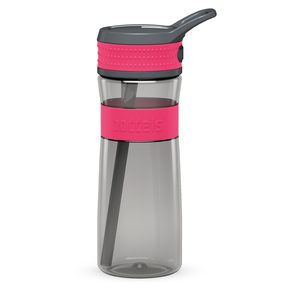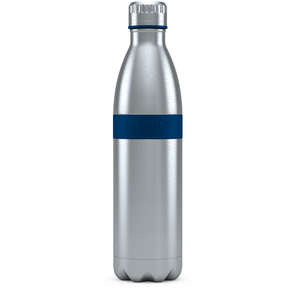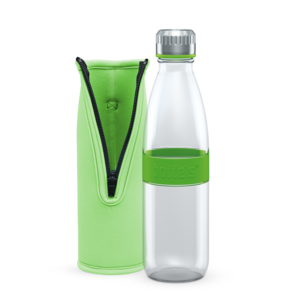![[Translate to Englisch:]](/fileadmin/_processed_/1/9/csm_een600_apfelgru__n_berg_hand_2_89827320a1.jpg)
Tritan
Tritan Copolyester is a thermoplastic developed by the US company Eastman Chemicals in 2007 and is characterized by its practical and innovative properties. These are its biggest advantages:
Perks
Breakproof: Drinking bottles made of tritan are especially durable, break-proof and long-lasting. That’s why they’re a great choice for children – for example the EEN kid’s bottle!
Light weight: Tritan bottles are very light-weighted, even when filled. That’s why they’re the perfect choice if you don’t want to carry that much extra weight with you.
Neutral in taste: Tritan doesn’t add any flavour or smell to the water inside the bottle. The material is food-safe and therefore poses no health risks.
Good price: You can get a really high-quality tritan bottle below 20€ - like our EEN tritan bottle!
Downsides
Not heat-resistant: Even though tritan holds high temperatures up to 80°C, exposing the material to heat can cause damage in the long run. That’s why tritan bottles aren’t suitable for hot beverages. When cleaning, a temperature of no more than 60°C is recommended.
Plastic: Even though tritan is not the same as plastic, it’s often rejected by people who try to live plastic-free. That’s okay – just stick with glass as an alternative.
→ If you want to learn more about the material tritan, we recommend reading this article. Good to remember: Tritan is not the same as plastic.
Stainless steel
Stainless steel is another very popular material for drinking bottles. There are several good reasons why:
Perks
Insulation: In order for a steel bottle to have an insulating function, it has to be double-walled. Those type of bottles can keep beverages hot for a long period of time – like the HEET insulating bottle, which keeps your drink hot up to 12 hours.
Suitable for carbonated beverages: Whether or not a bottle is suitable for carbonated beverages, is mainly decided by the lid. However, stainless steel is the best material for such bottles, as it can hold the pressure of the gas reliably. An example for such bottle is the TWEE drinking bottle.
Durable: Stainless steel is not as easy to break – sure, you might find some scratches as time goes on, but they usually don’t affect the functionality of the bottle.
Great variety: With stainless steel bottles, you have a lot to choose from – single- or double-walled, with an integrated cup or screw cap – you name it, it’s out there!
Downsides
Weight: Especially double-walled stainless steel bottles can weight quite a lot depending on the size, they’re also quite chunky to hold. Whether or not that’s a problem for you, is a matter of preference.
Metallic taste: Normally, stainless steel doesn’t transfer any taste to the water inside the bottle. However, such taste can occur when your lips come in contact with the steel – that’s a kind of chemical reaction happening and doesn’t come from the water itself.
→ Good to know: Stainless steel is not to be mistaken with aluminum – aluminum can in fact transfer particles into the water!
Glass
Glass bottles are gaining more and more popularity among drinking bottles – they look great, they’re nice to drink from and they are long-lasting. Here are their biggest advantages:
Perks
Neutral in taste: Glass bottles are completely taste- and odorless, no matter what beverages you use them for.
Easy to clean: Glass bottles are especially easy to clean, as their smooth surface on the inside prevents substances from sticking onto it.
Long-lasting: As long as you don’t break it, your glass bottle can be used for many years to come.
Scratch-resistant: Quality glass is resistant to scratches and your glass bottle will look good even after years of using it.
Downsides
Risk of breaking: Even high-quality glass can break when the bottle falls to the ground – this risk should be taken into consideration before buying. However, a neoprene bag around the bottle can reduce the chance of it breaking – like the DREE glass bottle that comes with the PACKJe neoprene bag.
Weight: High-quality, stable glass does weight more than tritan for example – especially when the bottle has more than 650 ml of filling volume. However, if you’re happy with a smaller bottle, then weight shouldn’t be a an issue.
As you might have already noticed, it all comes down to personal preferences when choosing a material for your bottle. Depending on what’s important to you, you can choose between different materials, designs and sizes. Discover the variety of BODDELS in our website or scroll down for our top picks!
- Share this post


